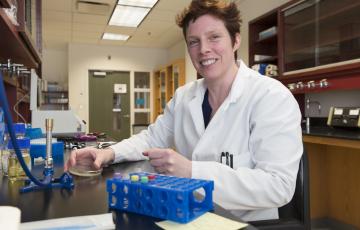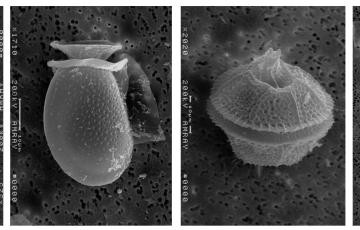Scientists Discover Source of Deep Ocean Color
 About half of atmospheric carbon dioxide is fixed by ocean's phytoplankton, mainly picocyanobacteria, through a process called photosynthesis. Picocyanobacteria are tiny, unicellular microorganisms that are abundant and widely distributed in freshwater and marine environments. A large portion of biologically fixed carbon is formed by picocyanobacteria at the sea surface and then transported to the deep ocean.
About half of atmospheric carbon dioxide is fixed by ocean's phytoplankton, mainly picocyanobacteria, through a process called photosynthesis. Picocyanobacteria are tiny, unicellular microorganisms that are abundant and widely distributed in freshwater and marine environments. A large portion of biologically fixed carbon is formed by picocyanobacteria at the sea surface and then transported to the deep ocean.
But what remains a mystery is how colored dissolved organic matter which originates from plant detritus (either on land or at sea) makes it into the deep ocean. A team of scientists from the University of Maryland Center for Environmental Science and around the world potentially found a viable marine source of this colored material.
“We are still at the beginning of understanding the marine carbon cycle,” said Michael Gonsior, a chemist at the University of Maryland Center for Environmental Science. “So far the sources of specific chemicals in the ocean are not well defined because it is such a vast and complex system. So any step forward to take apart the complexity makes this a valuable contribution.”
In the deep ocean, dissolved organic matter displays a fluorescence signal that looks like what you’d see in a river or stream. It has been traditionally named humic-like fluorescence, assuming it comes from degrading trees and other terrestrial organic matter.
Many scientists have hypothesized that this material found in the deep ocean is the remnants from rivers and streams around the world that carry it off the land and into the ocean. However, evidence is growing that there are marine sources of this material, which may well explain the majority of this colored material found in the deep ocean.
In this study, chemistry and biology meet to see what is the evolution of compounds coming from a specific organism. We can trace it with optical ways and explain a signature we’ve been seeing a long time but haven’t quite understood.
Michael Gonsior
Chesapeake Biological Laboratory scientist
UMCES researchers Feng Chen and Gonsior took the first step in characterizing organic matter released from marine picocyanobacteria.
 "Our original plan was to understand the fate of organic carbon released from viral lysis of picocyanobacteria," Chen said.
"Our original plan was to understand the fate of organic carbon released from viral lysis of picocyanobacteria," Chen said.
For the first time, researchers have shown that cultured picocyanobacteria, Synechococcus and Prochlorococcus, found in the open ocean release fluorescent components that closely match these typical fluorescent signals found in oceanic environments.
“Scientists never looked closely at picocyanobacteria as a source of specific compounds in the ocean before,” Gonsior said. “If we can understand what the sources are we can better infer what’s happening in terms of some elements of the marine carbon cycle.”
If ocean warming continues, it is predicted that picocyanobacteria, which prefer high temperatures, will become more abundant and could increase 10 to 20 percent by end of century, Chen said. “These guys are very important,” he added.
"Two genus of picocyanobacteria - Synechococus and Prochlorocccos - are the most abundant carbon fixers in the ocean," he said.
His lab maintains a collection of marine cyanobacteria and cyanoviruses. Some of these isolates were used in this study.
“When you sail on the blue ocean, a lot of picocyanbacteria are working there,” Gonsior said. "They turn carbon dioxide into organic carbon and are likely responsible for some of the deep ocean color coming from organic matter.”
Gonsior and Chen looked at the strain of Synechococus and stumbled upon the discovery. Chen, a molecular biologist, and Gonsior, a chemist, planned to measure the fate of dissolved organic matter by examining the molecular composition using state-of-the-art mass spectrometry undertaken in collaboration with Professor Philippe Schmitt-Kopplin at the Helmholtz Center for Environmental Health in Munich, Germany.
Many biological compounds glow when excited with light. Gonsior decided to do optical analyses that measured the absorbance and fluorescence, the kind he routinely does on water samples in his lab.
“When I saw the first fluorescence measurements of these samples, it was very clear what was going on. We found those picocyanobacteria were releasing fluorescent organic matter, which mimics that what we see in both the deep ocean, but also in rivers and streams,” Gonsior said. “A lot of people had been on the hunt for sources of this yellow colored material, and we’ve identified a viable source of marine fluorescent dissolved organic matter that may explain the signals observed in the deep global oceans.”
“To me this is exciting because you have such abundant photosynthetic cyanobacteria in the ocean,” Chen said. "We’ve known that for a long time but nobody made a connection between picocyanobacteria and fluorescent dissolved organic matter.”
The study, “Picocyanobacteria and deep-ocean fluorescent dissolved organic matter share similar optical properties,” appeared in the May 17 issue of Nature Communications.


